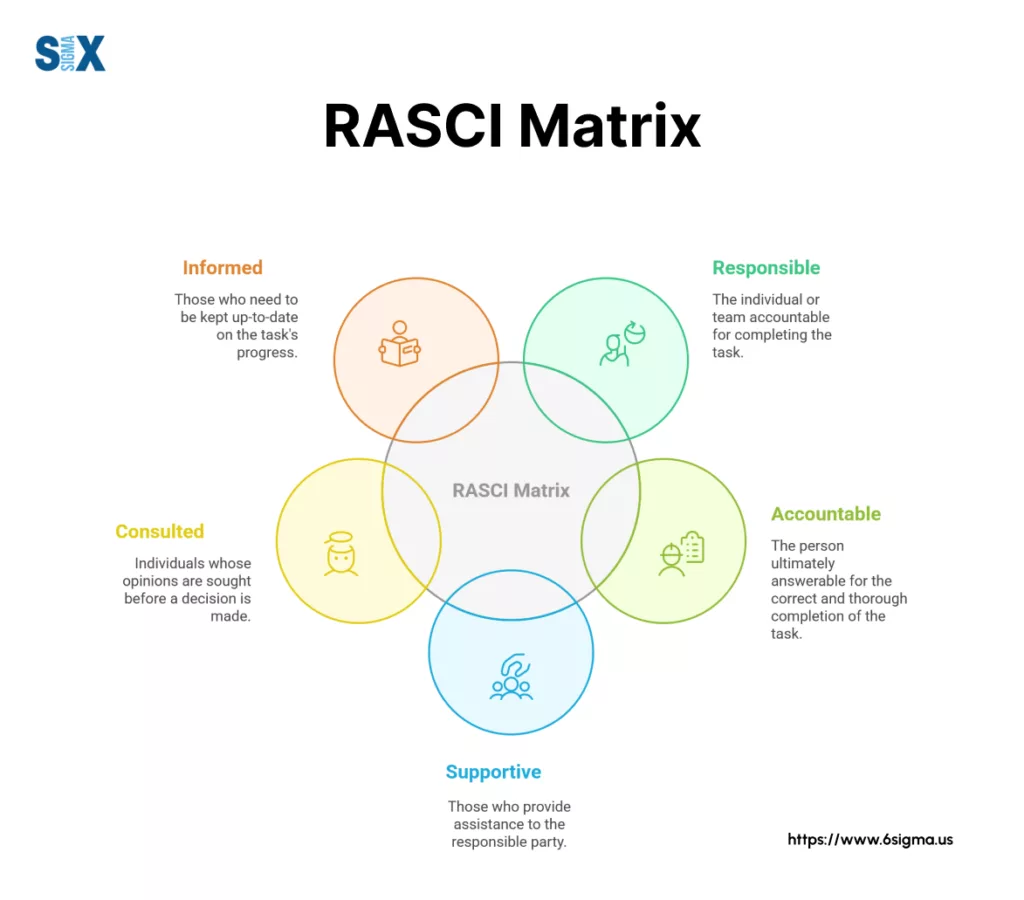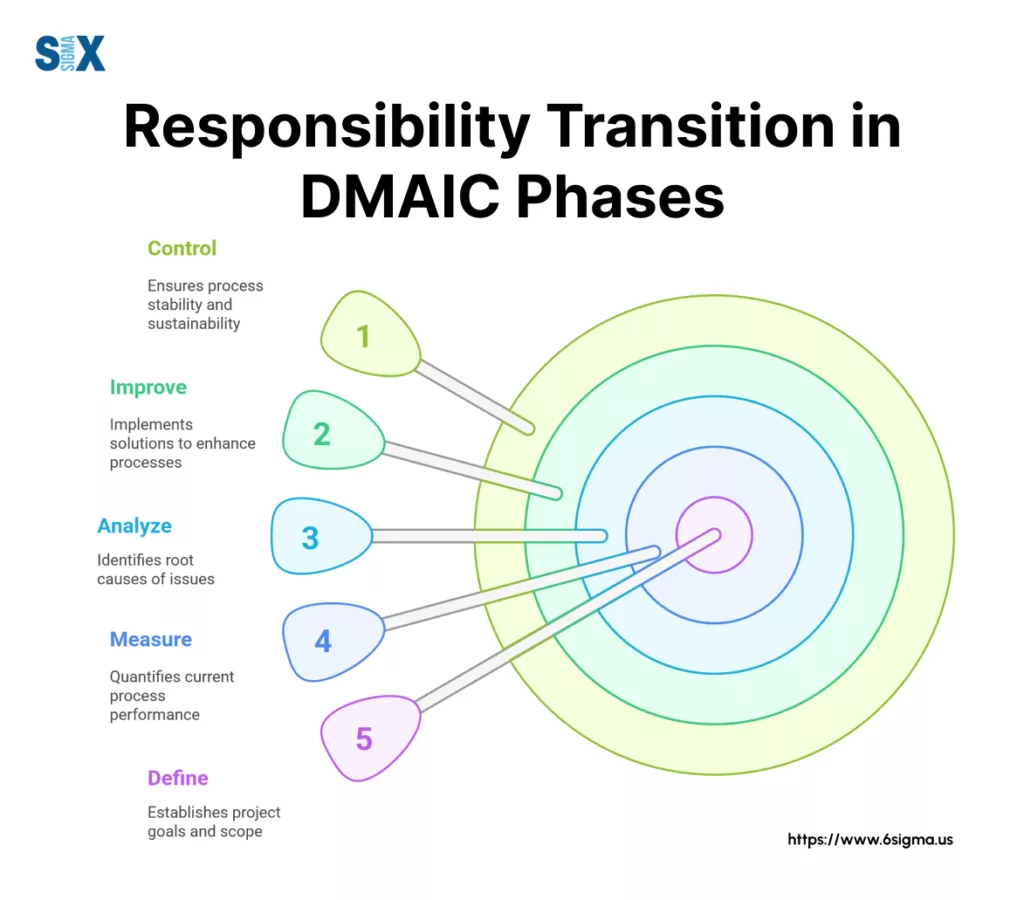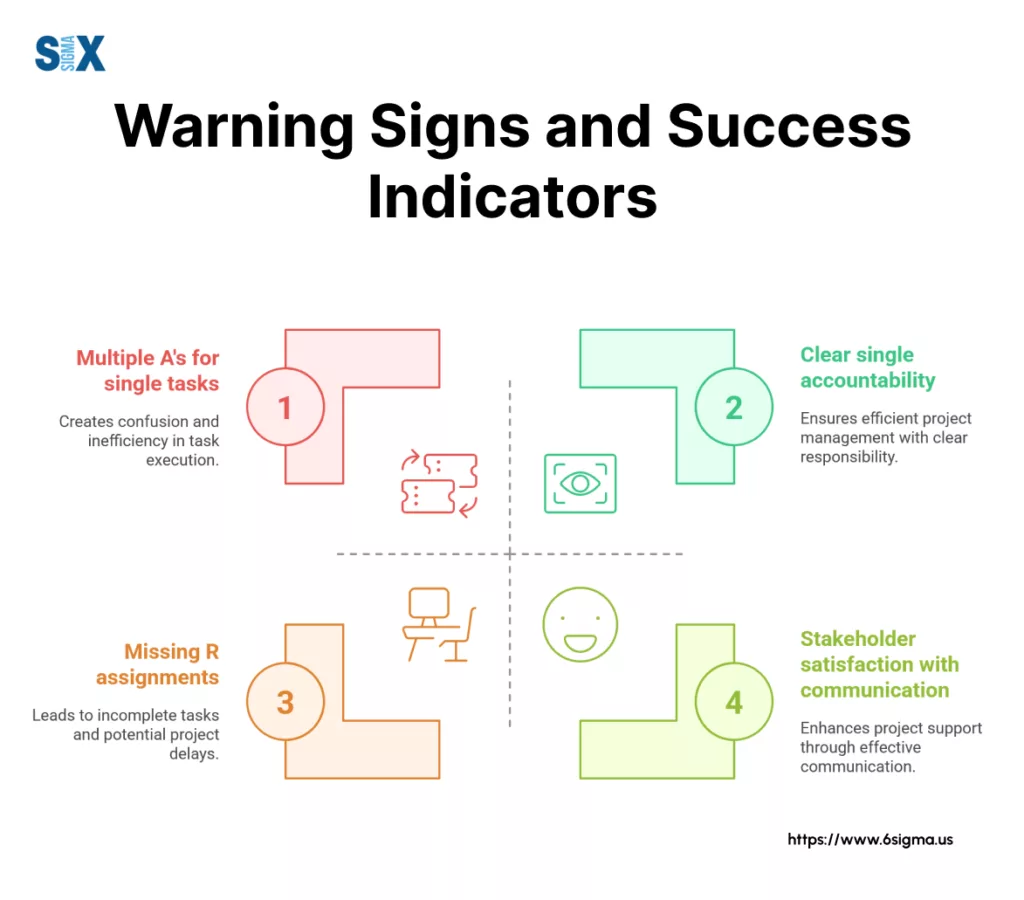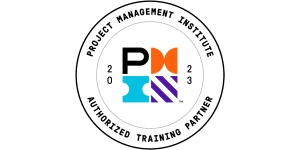Responsibility Assignment With RASCI Matrix in Lean Six Sigma Projects
A critical manufacturing process improvement project is spiraling into chaos. Deadlines are slipping, team members are duplicating efforts, and the project manager is drowning in confusion about who’s doing what. Sound familiar?
This was exactly the situation at a company until they implemented a RASCI Matrix—transforming their disorganized Six Sigma initiative into a model of clarity and efficiency.
The RASCI Matrix serves as a powerful responsibility assignment tool within Lean Six Sigma methodology.
When properly implemented, it eliminates the common “I thought you were handling that” syndrome that plagues many process improvement projects.
By clearly defining who’s Responsible, Accountable, Supportive, Consulted, and Informed for each task, RASCI creates a roadmap for project execution that aligns perfectly with Six Sigma’s data-driven, structured approach to eliminating defects.

Key Highlights
- RASCI fundamentals
- Implementation steps
- Six Sigma integration
- Real-world applications
- Troubleshooting tips
What Is RASCI Matrix Framework?
The RASCI Matrix is a project management tool that clarifies team roles and responsibilities for each task or deliverable.
This responsibility assignment matrix eliminates confusion by documenting exactly who does what during a project, particularly useful in Lean Six Sigma initiatives where cross-functional teams tackle complex process improvements.
Unlike vague role descriptions, the RASCI Matrix creates a structured framework that prevents both task duplication and critical gaps in project execution.
Many Six Sigma projects fail not from technical issues but from unclear responsibilities—the exact problem this matrix solves.
Definition And Core Purpose
The term “RASCI” functions as an acronym representing five distinct roles team members can play in project activities.
The RASCI Matrix definition centers on mapping these roles against project tasks in a table format, creating a visual responsibility roadmap.
The matrix serves several key purposes in Six Sigma projects:
- Eliminates role ambiguity during each DMAIC phase
- Prevents multiple “owners” claiming the same task
- Ensures necessary stakeholders remain informed
- Balances workload across team members
- Creates clear escalation paths when issues arise
The RASCI Components Breakdown
R – Responsible: The person who actually performs the work. This role handles the implementation and is directly involved in completing the task. In Six Sigma projects, Green Belts often take this role for specific improvement activities.
A – Accountable: The ultimate decision-maker who approves the work before it’s considered complete. Only one person should be accountable for each task—typically a Black Belt or project sponsor in Six Sigma initiatives. They answer for the outcome if things go wrong.
S – Supportive: People who provide resources or play a supporting role in completion. They actively help the Responsible person but aren’t directly accountable for results. Process operators and technical specialists often fill this role in Six Sigma projects.
C – Consulted: Subject matter experts whose opinions are sought before final decisions. These stakeholders provide input but don’t directly implement solutions. Statistical analysts and department heads typically serve as Consulted resources.
I – Informed: Those who need updates on progress or decisions, but don’t directly contribute to the task. Executive sponsors and adjacent department managers often need to stay informed without direct involvement.
The RASCI Matrix meaning becomes clear when you see how these roles interact within a Six Sigma project structure, creating a responsibility ecosystem that drives process improvement forward with minimal confusion.

RASCI vs. RACI: The Strategic Difference in Six Sigma
Many Six Sigma practitioners debate between using RASCI and RACI matrices for their projects.
While both tools clarify responsibilities, the RASCI model authority matrix offers distinct advantages for complex process improvement initiatives.
The Critical ‘S’ Component
The primary distinction between these frameworks is the addition of the “S” (Supportive) role in the RASCI Matrix.
This seemingly small addition creates significant practical benefits in Six Sigma projects where cross-functional collaboration is essential.
The Supportive role designates team members who actively assist with task execution but don’t bear primary responsibility. These individuals provide resources, expertise, or hands-on help to the Responsible person.
For example, in a manufacturing process improvement project, a maintenance technician might support a Green Belt by helping implement equipment modifications without owning the overall task.
Without the “S” designation, these supporting roles get lumped into either “R” (creating confusion about who’s actually accountable) or “C” (undervaluing their active contribution).
The RASCI framework acknowledges that support staff often do more than just provide input—they actively participate in implementation.
When To Choose RASCI Over RACI In Process Improvement
RASCI proves particularly valuable in these Six Sigma scenarios:
Projects with limited resources where team members must share implementation duties benefit from clearly defined support roles.
The RASCI Matrix prevents overloading primary responsible parties while ensuring support staff understand their active contribution expectations.
Complex DMAIC projects spanning multiple departments need the additional clarity that RASCI provides.
When improvement initiatives cross organizational boundaries, the supportive role creates bridges between functional silos.
High-stakes process improvements where failure risks are significant require the extra layer of resource allocation that RASCI enables.
By explicitly documenting support mechanisms, the matrix creates redundancy that prevents single points of failure.
Training-intensive implementations where knowledge transfer is critical benefit from designated supporters who assist while learning.
This structure proves especially valuable when developing new Six Sigma practitioners.
Key Differences In Table Format
| Feature | RACI Matrix | RASCI Matrix |
|---|---|---|
| Roles Defined | 4 (R,A,C,I) | 5 (R,A,S,C,I) |
| Support Function | Not explicitly defined | Clearly designated |
| Best For | Simpler projects with clear ownership | Complex initiatives requiring shared implementation |
| Resource Allocation | Less granular | More detailed |
| Team Size Suitability | Smaller teams | Larger cross-functional teams |
| Documentation Detail | Moderate | More extensive |
| Six Sigma Phase Value | Define, Control | All DMAIC phases, especially Improve |
The RASCI Matrix provides a more nuanced approach to responsibility assignment, particularly valuable in the complex, cross-functional environment of Six Sigma projects where support roles often make the difference between success and failure.
Creating a RASCI Matrix for Six Sigma Projects
Developing an effective RASCI Matrix requires thoughtful planning and team input.
When properly constructed, this tool transforms how Six Sigma teams operate by eliminating confusion and accelerating decision-making. Let’s walk through the practical steps to build a RASCI Matrix that drives process improvement success.
Step-by-Step Implementation Guide
Start by identifying all key deliverables and tasks in your Six Sigma project.
Break down major DMAIC phases into specific activities that require clear ownership. For a manufacturing process improvement project, you might list tasks like “Collect baseline defect data,” “Analyze root causes,” and “Implement control plan.”
Next, identify all stakeholders who will participate in or be affected by the project.
This typically includes the project sponsor, Black Belt, Green Belts, process owners, operators, and functional managers. Be thorough—forgetting a key stakeholder now creates problems later.
Create your matrix structure with tasks listed vertically on the left and stakeholders across the top. This grid forms the foundation of your RASCI matrix template.
Most teams use spreadsheet software for easy updates, though specialized project management tools also work well.
Hold a dedicated workshop with key team members to assign RASCI roles for each task-stakeholder intersection. This collaborative approach ensures buy-in and surfaces potential conflicts early.
Fill each cell with R, A, S, C, I, or leave blank as appropriate.
Review the completed draft with the entire team to validate assignments. This step often reveals overlooked dependencies or unrealistic expectations. Make adjustments based on feedback before finalizing.
Distribute the approved RASCI matrix example to all stakeholders and store it in an accessible location. Many Six Sigma teams include it in their project charter documentation for easy reference throughout the DMAIC process.
Vertical and Horizontal Analysis
After completing your initial RASCI Matrix, conduct both vertical and horizontal analyses to identify potential issues:
Vertical analysis examines each stakeholder’s column to evaluate workload distribution. Look for individuals with too many R’s, which indicates potential overload. In Six Sigma projects, Green Belts often end up with excessive responsibilities that jeopardize timeline commitments.
Horizontal analysis reviews each task row to check for proper role coverage. Every task needs exactly one A (Accountable) person and at least one R (Responsible) person. Multiple A’s create confusion about final decision authority—a common pitfall in cross-functional process improvement initiatives.
Check for appropriate distribution of S (Supportive) roles, especially for technically complex tasks. Six Sigma projects often require specialized support during measurement system analysis or statistical evaluation phases.
Verify that C (Consulted) designations match subject matter expertise requirements. Too many C’s can create bottlenecks during implementation, while too few might miss critical insights from experienced team members.
Integration with DMAIC Methodology
The RASCI Matrix should align directly with the DMAIC phases of your Six Sigma project:
During Define, focus on high-level responsibilities for project scoping, charter development, and team formation. The project sponsor typically holds Accountable roles while Black Belts are Responsible for most activities.
For Measure phase tasks, assign detailed responsibilities for data collection, measurement system analysis, and baseline capability studies. This phase often requires multiple Supportive roles from operational staff.
In Analyze, clarify who leads various analytical methods (Responsible) versus who provides technical expertise (Consulted). Statistical specialists often serve in Consulted roles during this phase.
The Improve phase demands clear delineation of implementation responsibilities, with particular attention to Supportive roles that help execute solutions. This phase typically involves the most stakeholders and benefits greatly from RASCI clarity.
For Control, assign specific responsibilities for monitoring, response plans, and process documentation. Process owners usually transition to Accountable roles during this phase as the project team prepares to exit.
Tired of project confusion and ready to apply tools like RASCI effectively?
Master the fundamentals and kickstart impactful improvements with our Green Belt Bootcamp.

RASCI Applications in Different Six Sigma Phases
The RASCI framework proves particularly valuable when mapped to the structured DMAIC methodology of Six Sigma.
Each phase presents unique responsibility challenges that the RASCI Matrix helps resolve. Let’s explore how this project management tool enhances clarity throughout the Six Sigma journey.
Define Phase Applications
During the Define phase, the RASCI Matrix establishes foundational role clarity that prevents later confusion.
Project sponsors typically take Accountable roles for charter approval and scope definition, while Black Belts are Responsible for developing these documents.
The Define phase often involves numerous stakeholders who need to be Consulted about business impacts and process boundaries.
The RASCI framework helps distinguish between true decision-makers and those who simply need awareness. This distinction prevents the “too many cooks” syndrome that often delays project kickoffs.
Support roles during Define are often overlooked but critical—finance staff supporting business case development or IT personnel helping with data access planning benefit from clear “S” designations in your RASCI Matrix.
Measure Phase Implementation
The Measure phase demands precise responsibility assignments for data collection activities. Green Belts typically hold responsible roles for measurement system analysis and baseline data gathering, while process operators provide Support through their hands-on involvement.
Department managers often transition to Informed status during Measure, needing updates but not direct involvement in technical measurement activities.\
The RASCI Matrix makes these shifts explicit, preventing managers from micromanaging technical work.
Quality engineers and statistical experts frequently serve in Consulted capacities during measurement system validation. Their expertise informs the approach without making them responsible for execution—a distinction that RASCI captures perfectly.
Analyze Phase Usage
During Analysis, the RASCI framework helps navigate the complex web of technical expertise and process knowledge required. Data scientists might be Responsible for statistical analysis while process experts are Consulted to interpret results in context.
The Analyze phase often reveals new stakeholders who weren’t initially identified. The flexible RASCI Matrix allows for adding these roles and clearly defining their contributions without disrupting existing assignments.
Support roles become particularly important when specialized analysis tools or software are needed. IT personnel or external consultants who provide technical assistance without owning outcomes benefit from clear “S” designations in the RASCI project management structure.
Improve Phase Integration
The Improve phase typically involves the most stakeholders and the highest implementation risks, making RASCI clarity essential. Process owners often transition from Consulted to Accountable roles as solutions move toward implementation.
Cross-functional implementation teams benefit from explicit Responsible and Supportive designations that prevent both gaps and overlaps in execution efforts. The RASCI Matrix provides visual confirmation that all implementation aspects have clear owners.
Change management activities during Improve require careful RASCI mapping to ensure communication flows properly. Those Informed about changes must be distinguished from those Consulted on implementation approaches—a nuance the RASCI framework handles effectively.
Control Phase Maintenance
During Control, responsibility transitions from project team to process owners. The RASCI Matrix documents this handoff explicitly, showing how Accountable and Responsible roles shift from Black Belts to operational leaders.
Training responsibilities for sustaining improvements benefit from clear RASCI designations. Who develops materials (Responsible) versus who approves content (Accountable) versus who delivers training (Support) must be unambiguous for successful knowledge transfer.
Monitoring responsibilities in the Control phase require particular clarity about escalation paths when metrics show deterioration.
The RASCI framework documents who is Informed about issues versus who is Responsible for corrective actions, preventing delayed responses to process drift.

Move beyond theory and confidently lead projects using RASCI and DMAIC.
Become a certified Lean Six Sigma Green Belt and drive measurable process improvements.
Best Practices and Common Pitfalls
Even the most carefully designed RASCI Matrix can fail without proper implementation and maintenance.
A thorough RASCI matrix explanation must include not just the what but the how of effective implementation.
Success Factors in Six Sigma Implementation
Executive sponsorship proves crucial for RASCI adoption. When leadership actively references and uses the matrix in discussions, other team members follow suit. Make the RASCI Matrix a standard agenda item in project reviews to reinforce its importance.
Keep your matrix visible and accessible to all stakeholders. Many successful teams display large printed versions in project rooms and include digital copies in all team communications. This constant visibility transforms RASCI from a document into a working tool.
Review and update the matrix at key project milestones. As Six Sigma projects progress through DMAIC phases, responsibilities naturally shift. Schedule regular reviews to ensure the matrix reflects current reality rather than outdated plans.
Train all team members on RASCI fundamentals before implementation. Many resistance issues stem from misunderstanding the framework rather than disagreeing with assignments. A 30-minute orientation session prevents hours of later confusion.
Document the reasoning behind key assignments, especially for contentious responsibilities. This context helps resolve disputes and provides valuable information when onboarding new team members mid-project.
Troubleshooting Guide
When tasks consistently miss deadlines, check for overloaded Responsible parties. The most common RASCI implementation flaw involves assigning too many R’s to the same person without considering their total workload across all projects.
If stakeholders frequently express surprise about decisions, examine your Consulted and Informed designations.
Communication breakdowns often indicate that people expected to be Consulted were merely Informed—or worse, completely overlooked.
When multiple people claim ownership of the same deliverable, revisit your Accountable assignments. Remember the “single throat to choke” principle—each task needs exactly one A, even in matrix organizations with complex reporting structures.
If support resources aren’t available when needed, verify that Supportive roles are explicitly documented and communicated. Many teams mistakenly assume support will materialize without formal RASCI designation.
When conflicts arise between process owners and project teams, check for alignment between RASCI assignments and organizational authority. The matrix should reflect, not contradict, the organization’s power structure.
Quality Control Checkpoints
Conduct these specific checks to verify your RASCI Matrix quality:
Every task must have exactly one Accountable person. Multiple A’s create confusion about final decision authority, while missing A’s leave no clear approval path. This single-accountability principle forms the backbone of effective RASCI implementation.
Each task requires at least one Responsible party but can have multiple R’s if the work is truly shared. However, shared responsibility demands clear subtask boundaries to prevent duplication or gaps.
Support roles should be specific about what support entails. Vague S designations without clarifying notes lead to mismatched expectations about the type and timing of assistance provided.
Check that Consulted stakeholders have the expertise and availability to fulfill their advisory role. Consulting the wrong experts or overburdening key advisors with too many C designations undermines decision quality.
Verify that Informed stakeholders actually receive the information they need. Many RASCI implementations fail not in the assignment of I roles but in the execution of communication plans to those stakeholders.

Frequently Asked Questions About The RASCI Matrix
A. RASCI is an acronym representing the five key roles in this responsibility assignment framework:
R: Responsible – The person who performs the work
A: Accountable – The decision-maker who approves the work
S: Supportive – Those who provide resources or assistance
C: Consulted – Subject matter experts who provide input
I: Informed – Stakeholders who need to know outcomes
Each letter represents a specific relationship between team members and project tasks. The RASCI Matrix maps these relationships in a grid format, creating clarity about who does what throughout a project lifecycle.
A. Neither framework is universally “better” – their value depends on project complexity and team structure. RASCI offers more nuance by adding the Supportive role, making it advantageous for:
– Large, complex projects with shared implementation responsibilities
– Cross-functional teams where active assistance (not just consultation) is needed
– Situations where resource allocation requires detailed documentation
– Projects where distinguishing between active support and mere consultation matters
RACI works well for simpler projects with clear ownership boundaries. Many organizations start with RACI and evolve to RASCI as their projects grow more complex and their process maturity increases.
A. he RACI Matrix is the predecessor to RASCI and stands for:
R: Responsible
A: Accountable
C: Consulted
I: Informed
This four-role framework serves the same fundamental purpose as RASCI – clarifying task ownership and stakeholder involvement. The key difference is that RACI lacks the explicit Supportive role found in the RASCI Matrix.
A. he “S” in RASCI stands for Supportive – people who actively help complete tasks without primary responsibility.
This role fills an important gap in the original RACI model by acknowledging team members who:
Provide hands-on assistance to the Responsible person
Contribute resources, time, or expertise to task completion
Help with implementation but don’t make final decisions
Work alongside the Responsible person rather than just offering advice
The Supportive role differs from Consulted because it involves active participation rather than just providing input. It differs from Responsible because ultimate ownership remains with the R Role.
A. Effective RASCI implementation follows several key rules:
– Every task must have exactly one Accountable person – no more, no less. This “single point of accountability” principle prevents confusion about final decision authority.
– Each task requires at least one Responsible person but can have multiple R’s if work is truly shared. – When multiple R’s exist, their specific areas of responsibility should be clearly defined.
– Supportive roles should specify what type of support is provided. Simply marking someone as “S” without clarification leads to misunderstandings about expectations.
– Consulted stakeholders must be engaged before decisions are finalized. The C designation creates an obligation for two-way communication before proceeding.
– Informed stakeholders should receive updates after decisions or actions, but don’t need to be consulted beforehand. This one-way communication keeps people in the loop without creating bottlenecks.
– Every role in the RASCI Matrix should add value. Avoid unnecessary assignments that create work without benefit.
– The matrix should be a living document, updated as roles and responsibilities evolve throughout the project lifecycle.
Following these rules ensures your RASCI Matrix serves as an effective tool for clarifying responsibilities and improving project execution.
SixSigma.us offers both Live Virtual classes as well as Online Self-Paced training. Most option includes access to the same great Master Black Belt instructors that teach our World Class in-person sessions. Sign-up today!
Virtual Classroom Training Programs Self-Paced Online Training Programs






